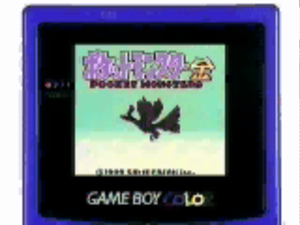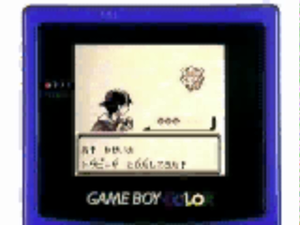Pokémon Gold and Silver beta
Pokémon Gold and Silver, released in 1999 in Japan and 2000 elsewhere, were in development for a long time beforehand. Several aspects from their beta versions were released to the public during their development, many including aspects that did not make it to the final games.
First mention of Pocket Monsters 2
In 1997, Nintendo announced the first details of the next generation of Pocket Monsters games, to be titled Pocket Monsters 2: Gold and Silver. The games were intended to be released at the end of the year for both Game Boy and Super Game Boy.
One of the many additions promised, notably, was a skateboard that could be used in addition to the Bicycle of the previous games and would allow users to travel to "unusual places". Though this never made the final cut, other things announced, such as the real-time clock, 100 new Pokémon, including new evolutions of old Pokémon, new TMs and HMs containing new moves were included. The trading and communication abilities of the games were also to be improved, and backwards compatibility with the Generation I games was also announced.
New Pokémon in the anime
The anime also provided early looks at the new Pokémon. Ho-Oh, the eventual version mascot of Pokémon Gold, had already appeared in the first episode as an unidentified creature. Later, Togepi hatched from an egg Ash himself found, and Misty became the first main character to own a Generation II Pokémon. Snubbull and Marill made their first appearances in Pikachu's Vacation, and Donphan appeared at the start of Mewtwo Strikes Back. During the second season, Ash and Misty also encountered Tracey, who owned a Marill, and the focus of the second movie was Lugia, the version mascot of Pokémon Silver. Bellossom, Ledyba, Hoothoot, and Elekid also made an appearance in Pikachu's Rescue Adventure
First screenshots
The color scheme in these screenshots was not as varied as the one provided by the Game Boy Color; this town was also ultimately either changed into Violet City (perhaps with Sprout Tower at left) or removed altogether.
This screenshot displays an area which made it into the game's final cut with little alteration. Replace the water with trees and fences and open a path to the right, and a simplified version of Route 35 and the National Park's southern entrance materialize.
A possible early design for the Johto Radio Tower can be seen on the right-hand side of this screenshot.
At this time, the early game screenshots realesed generally didn't look all that much different from Generation I. The pictures clearly show the games' engine being in a more developed but still early stage. The lack of battle images would seem to indicate that a redone battle system had not been implemented yet.
Pokémon Gold and Silver Versions announced
The end of 1997 passed without a release for Pocket Monsters 2. The potential release date was removed, and things generally stayed quiet until early 1998.
It was at this time that Pocket Monsters 2 was re-announced as Pokémon Gold and Silver. Though the "2" was dropped, the games remained essentially a sequel to Generation I. Much of the year was quiet with regard to information about the games, as Pokémon Yellow was on its way out in Japan, and Pokémon Red and Blue and the Pokémon anime were on their way to the United States.
New information emerges
Following nearly a year without press releases, the Nintendo site was finally updated with new information on Pokémon Gold and Silver. A revised release date of June, 1999 was given and it was announced the games would be compatible with the then soon-to-be-released Game Boy Color.
Ken Sugimori's artwork for Slowking, Marill, Bellossom, and Hoothoot was also released, as were several screens of the new battle system featuring full-color sprites.
- 1999 art yado1.gif
- 1999 art cara 1.gif
- 1999 art cara 2.gif
- 1999 art cara 3.gif
- 1999 shot p2.gif
Butterfree vs. Venusaur
- 1999 shot p3.gif
Player vs. Picnicker Kanami
The battle screens are very similar to the final ones; however, the absence of gender notation is apparent. Pokémon gender was a previously announced feature, and the display of gender during battle was likely added later as a convenience to players.
The attack stats window, which in the final version tells players the remaining and total PP of each move, as well as its type, was apparently not fully completed at this point in development.
The battle system, nearly complete, was demonstrated, including wild Pokémon encounters. The new Pokédex, while close to completion, was still missing several features, such as the footprint and National Dex number of the Pokémon. The "location", "cry", and "print" functions were also missing.
On-field images of game looking closer to the final. The locations don't seem to be that of the final map, though are close. The colors seem more washed out than they do in the final version, though this may be due to the fact that they are pictures of a Game Boy Color screen.
After the release
Since Pokémon Gold and Silver were released, other things have been uncovered that reveal interesting details about the games' development. The final games have full beta maps of every single Johto town remaining in their ROM, most of which are significantly different from their final counterparts. One particular beta map found in the ROM seems to be detailing the Safari Zone, which didn't make it into the final game itself, possibly due to the risks of Glitch City. [1] Apart from maps, other beta discoveries include a mine cart image, strange text and evidence of another Game Corner game.[2]
Images have also since been found of various early ideas for the new Pokémon, including early prototypes of Qwilfish, Chikorita, and Marill.
References
- Pokémon GS Pre-Release Images
- IGN Pocket
- Pkmn.co.uk Pokémon GS Beta Information
- Pkmn.co.uk Lost Pokémon!
- Pkmn.co.uk GS Beta Maps (Requires registration)
- Tohjo Falls Gold Beta Game Corner
- Tohjo Falls Crystal Text Dump
- Pokémon Depot Lost Stuff
- Pokefor.tk Pokémon GS Pre-Release (Wayback)
- Different archived versions of Nintendo of Japan's and IGN's GameBoy website.

